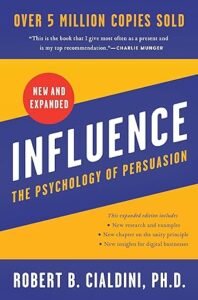Introduction: Why You Need This Book (Even If You Think You Don’t)

Imagine you’re a Jedi, but instead of a lightsaber, you wield the power of persuasion. Sounds cool, right? Well, that’s essentially what Robert B. Cialdini hands you in his book, “Influence, New and Expanded: The Psychology of Persuasion.” It’s like the manual to human behavior you never knew you needed—until now.
Whether you’re trying to convince your boss that a four-day workweek is the key to productivity, or you’re just trying to get your friend to finally pick a restaurant, Cialdini’s principles of persuasion will turn you into a negotiation ninja. But don’t worry, this isn’t about tricking people into doing your bidding. It’s about understanding why people say “yes” and how you can ethically get them to do so more often.
So, grab your coffee, settle in, and let’s dive into the psychology of why we do what we do—starting with how you can use this knowledge for good (and maybe a little bit of fun).
The Six Principles of Persuasion: Jedi Mind Tricks or Just Good Marketing?

Let’s break down Cialdini’s six principles of persuasion—think of them as your toolkit for influencing people without becoming a used-car salesperson.
1. Reciprocity: The Art of Giving to Get
Imagine walking into a grocery store, and the nice lady hands you a free sample of cheese. Five minutes later, you’re at the checkout with a whole block of that cheese. Coincidence? Nope. It’s the principle of reciprocity at work.
When someone does something nice for us, we naturally want to return the favor—even if that favor is buying something we didn’t really need. This principle is why marketers love free trials, and why your neighbor will probably mow your lawn after you lend them your lawnmower (unless they’re that one guy who never returns anything).
Pro Tip: Want to use reciprocity in your life? Start small. Send a thoughtful thank-you email or give a compliment. You’ll be surprised how often people feel compelled to return the favor.
2. Commitment and Consistency: The Power of Keeping Your Word
Ever made a New Year’s resolution, told everyone about it, and then felt a weird pressure to stick with it? That’s commitment and consistency at play. Once we commit to something, especially publicly, we feel an internal (and often external) pressure to follow through.
Cialdini argues that when people commit to something small, they’re more likely to stick with it and even agree to bigger requests later. It’s why those “foot-in-the-door” sales techniques work so well.
Pro Tip: Get someone to commit to something small first. It’s like laying the groundwork for future collaboration. Start by asking for their opinion on a project, then gradually involve them more. Before you know it, they’re co-leading the team with you.
3. Social Proof: Because Everyone Else is Doing It
Humans are pack animals at heart. If everyone else is doing something, we’re more likely to do it too. Social proof is why those “bestseller” tags on Amazon work so well, and why you’re more likely to try a restaurant that’s buzzing with people rather than one that’s completely empty.
The idea is simple: if other people like it, it must be good.
Pro Tip: Use social proof in your personal life by highlighting what others are doing. If you’re organizing a group event, mention who’s already attending. People are more likely to join if they see that others are interested too.
4. Authority: Trusting the Experts (Or Anyone in a Lab Coat)
People tend to follow the lead of credible, knowledgeable experts. This is why we listen to doctors, or at least someone who sounds like one on TV. Authority figures wield significant influence, whether it’s a scientist, a teacher, or that one friend who always knows the best restaurants.
Cialdini notes that authority can be powerful, but it must be earned and perceived as genuine. No one likes a know-it-all unless they actually do, in fact, know it all.
Pro Tip: Establish your authority by showcasing your expertise. Whether it’s through sharing your credentials, experiences, or even just well-researched information, people are more likely to follow your lead if they trust your knowledge.
5. Liking: The Friend Zone of Persuasion
We say “yes” to people we like. It’s a simple yet powerful principle. We’re more likely to be influenced by people we find attractive, similar, or just downright friendly. This is why salespeople try to build rapport and why that charming barista can convince you to upgrade to a large latte even when you were perfectly content with a small.
But here’s the kicker: liking doesn’t just apply to people. It applies to ideas, brands, and even hobbies. The more we like something or someone, the more likely we are to be persuaded by them.
Pro Tip: To increase your likability, find common ground with others. Shared interests, mutual friends, or even a shared dislike for Mondays can go a long way in building rapport.
6. Scarcity: The Fear of Missing Out
Ever bought something because it was “limited edition” or because there were “only a few left in stock”? That’s scarcity working its magic. We value things more when they’re hard to get. It’s why people camp out for the latest iPhone or why you suddenly crave that last piece of cake.
Scarcity creates a sense of urgency, making us act quickly to avoid missing out. But beware—overusing this tactic can backfire if people catch on that it’s just a sales gimmick.
Pro Tip: Use scarcity wisely. Whether it’s in your marketing strategy or just convincing your friends to make plans sooner rather than later, the fear of missing out is a powerful motivator.
The Ethics of Persuasion: With Great Power Comes Great Responsibility

Before you go off and start using these principles to get your way in every situation, let’s talk ethics. Persuasion isn’t about manipulation; it’s about understanding human behavior and helping others make decisions that benefit both parties.
Cialdini emphasizes that these principles should be used ethically and responsibly. It’s not about tricking people but about creating win-win situations. When used correctly, persuasion can be a tool for good, fostering collaboration, and building stronger relationships.
So, next time you’re about to use one of these principles, ask yourself: Am I using this to genuinely help the other person, or just to get what I want? If it’s the latter, it might be time to rethink your approach.
Real-Life Applications: How to Use These Principles Without Turning Into a Villain

Okay, now that we’ve covered the basics, let’s get practical. How can you use these principles in everyday life without feeling like a puppet master?
1. At Work: Getting Buy-In from Your Team
Imagine you’re pitching a new project to your team. Use the principle of social proof by highlighting how other successful companies have implemented similar ideas. Add a dash of authority by citing an expert or a well-respected industry leader who supports your concept.
Then, get a small commitment from your team by asking them to contribute ideas. Once they’re invested, they’re more likely to support the project all the way through.
2. In Your Personal Life: Negotiating with Your Kids (or Spouse)
Let’s say you want your kids to clean their rooms. Instead of just telling them to do it, try reciprocity. Offer to help them with something they enjoy first, like a fun activity or extra screen time, and then ask them to tidy up. They’ll feel more inclined to return the favor.
Or, if you’re negotiating with your spouse about where to go on vacation, use liking and commitment. Start by finding common ground on what you both enjoy and make a small decision together, like choosing a destination. Once you’ve both committed to the idea, it’s easier to agree on the details.
3. In Social Situations: Being the Life of the Party (Without the Karaoke)
If you’re at a social event and want to make a great impression, use the principle of liking. Find something you genuinely appreciate about the person you’re talking to, and mention it. People love compliments, especially when they feel sincere.
Want to subtly influence the group to choose a restaurant you like? Use social proof by mentioning how many rave reviews it has or how a mutual friend loves it. Before you know it, everyone’s on board.
Why Persuasion Matters in a Growth Mindset
You might be wondering, “How does all this persuasion stuff tie into personal growth?” Well, here’s the thing: Understanding the principles of persuasion can be a game-changer in how you approach your goals, relationships, and challenges.
When you know how to persuade yourself and others effectively, you can unlock doors that were previously closed. Whether it’s persuading yourself to stick to a new habit, convincing your team to embrace a new idea, or even just getting your friends to try that weird new sushi place, persuasion is a tool that can help you grow.
But remember, with great power comes great responsibility. Use these principles wisely, and you’ll find that they can be a force for good in both your personal and professional life.
Conclusion: Go Forth and Influence (Ethically, of Course)
Robert Cialdini’s “Influence, New and Expanded: The Psychology of Persuasion” isn’t just a book; it’s a guide to understanding the subtle forces that drive human behavior. Whether you’re a marketer, a manager, or just someone trying to get through daily life, these principles of persuasion are tools you can use to navigate the world more effectively.
So, go forth and influence—but do it ethically. After all, the goal isn’t just to get what you want; it’s to create win-win situations that help everyone involved.
And remember, the next time someone hands you a free sample, there’s probably a reason you’ll find yourself at the checkout with more than you intended to buy. But hey, now you know why.
Want to Read this book for yourself, grab it at this link: Influence, New and Expanded: The Psychology of Persuasion
